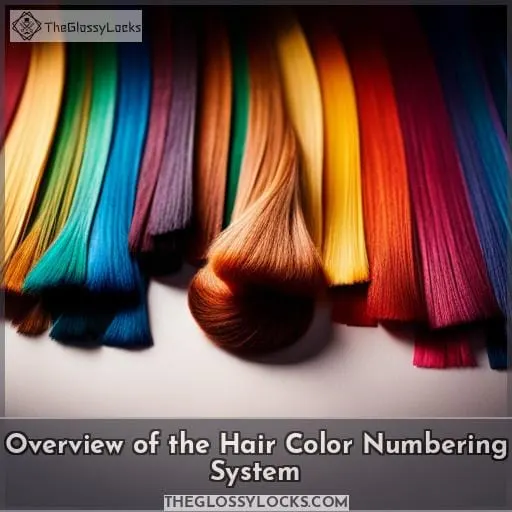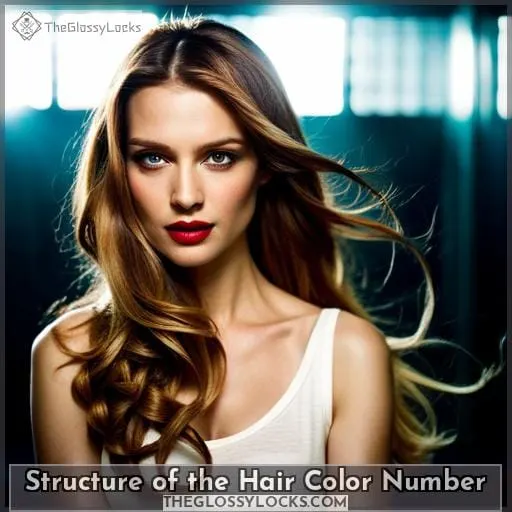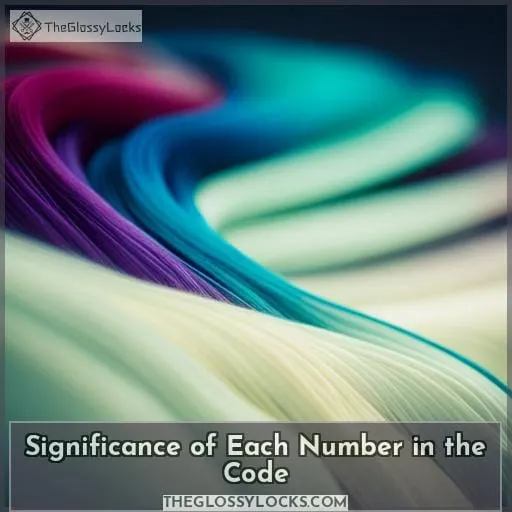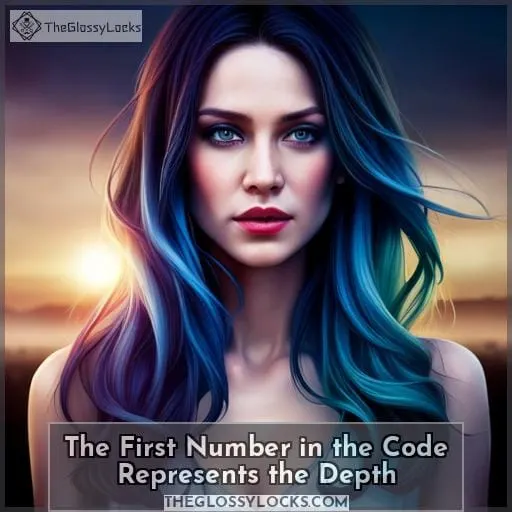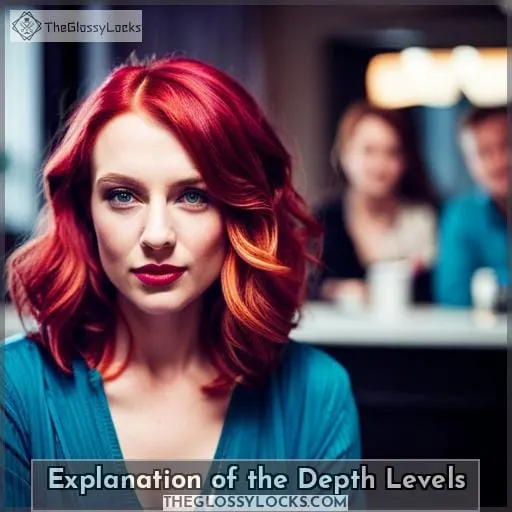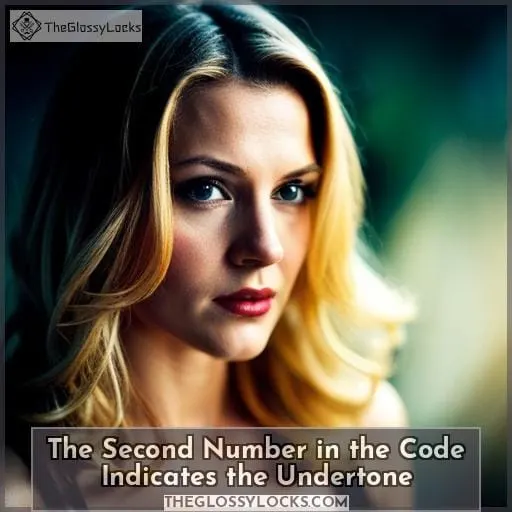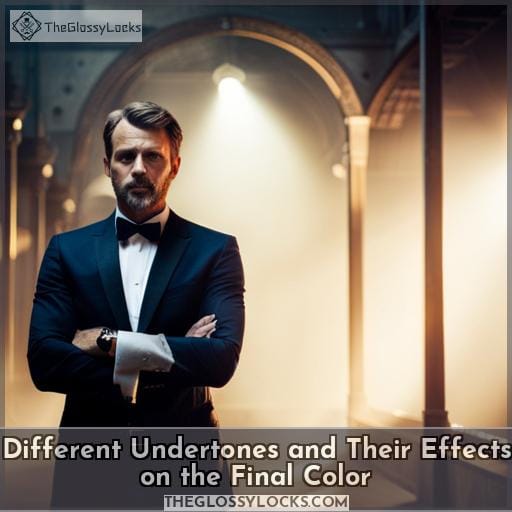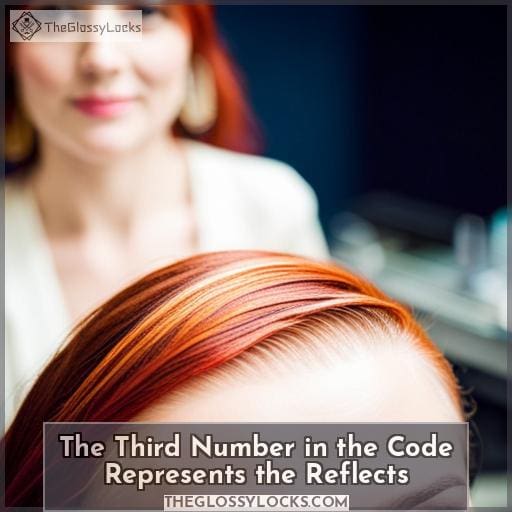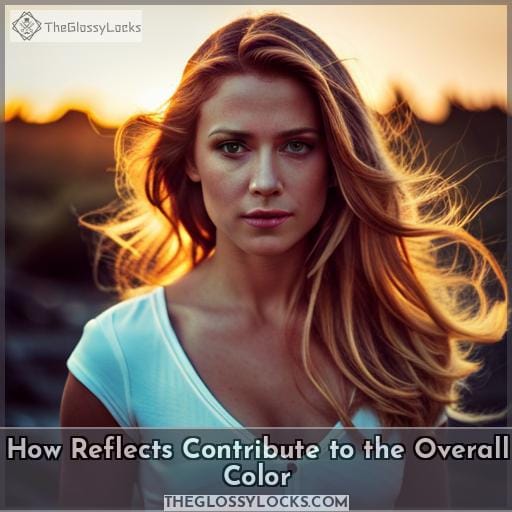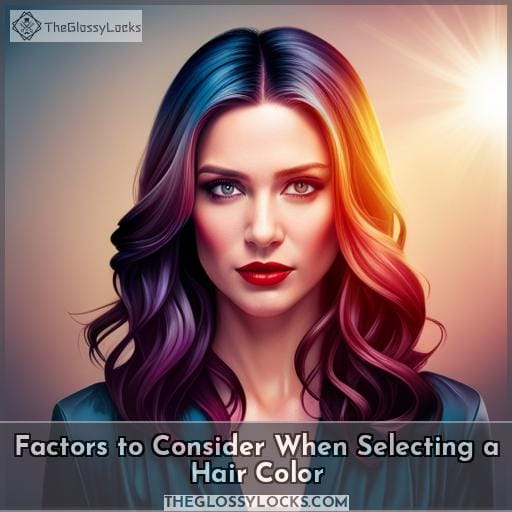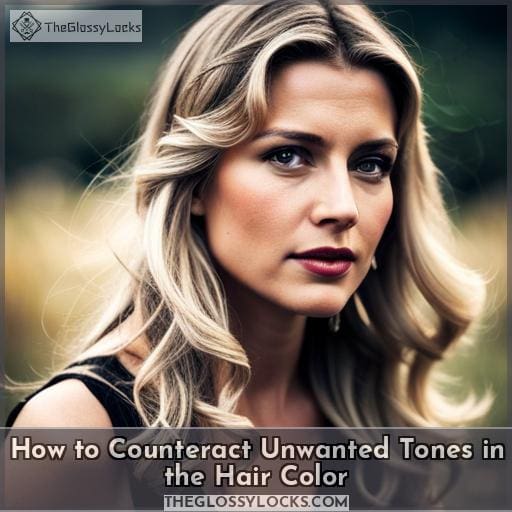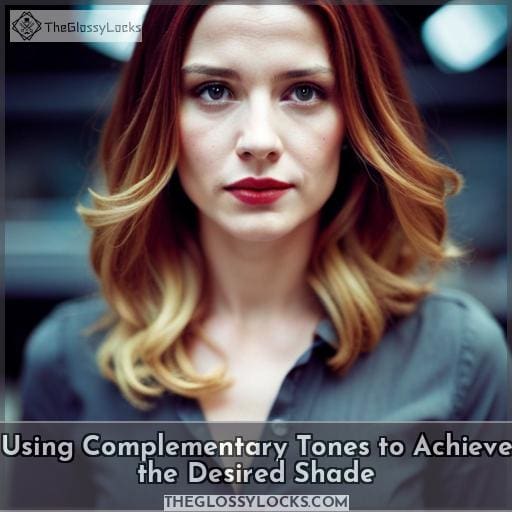This site is supported by our readers. We may earn a commission, at no cost to you, if you purchase through links.
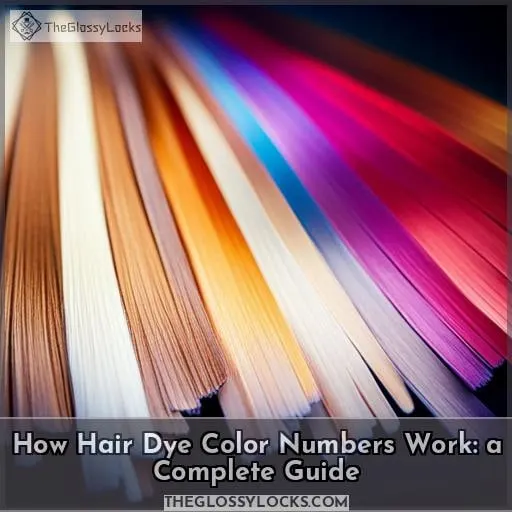 Discover how hair dye color numbers work and unlock the secrets to achieving your desired shade.
Discover how hair dye color numbers work and unlock the secrets to achieving your desired shade.
Understanding the intricacies of the numbering system is crucial when selecting a hair color that suits you best. From depth levels to undertones, each number plays a significant role in creating your perfect look.
Dive into this complete guide, packed with expert knowledge and precise details, to gain control over your hair color journey like never before.
Table Of Contents
- Key Takeaways
- Overview of the Hair Color Numbering System
- Structure of the Hair Color Number
- Significance of Each Number in the Code
- The First Number in the Code Represents the Depth
- Explanation of the Depth Levels
- The Second Number in the Code Indicates the Undertone
- Different Undertones and Their Effects on the Final Color
- The Third Number in the Code Represents the Reflects
- How Reflects Contribute to the Overall Color
- Factors to Consider When Selecting a Hair Color
- Matching the Depth and Undertone to Achieve Desired Results
- How to Counteract Unwanted Tones in the Hair Color
- Using Complementary Tones to Achieve the Desired Shade
- Frequently Asked Questions (FAQs)
- What are some examples of hair dye color codes and their corresponding shades?
- Are there any variations in the hair dye numbering system across different brands?
- How do hair color reflects contribute to the overall color of the hair?
- Can you provide some tips for choosing the right hair color based on depth and undertone?
- What are some common techniques for counteracting unwanted tones in hair color?
- Conclusion
Key Takeaways
- Hair color numbers consist of three digits indicating depth, undertone, and reflects.
- The first digit represents the depth level, ranging from 1 (darkest black) to 10 (lightest blonde).
- The second digit indicates the undertone, such as Ash or Golden.
- The third digit represents reflects, which subtly contribute to overall shade variations.
Overview of the Hair Color Numbering System
Wondering how the hair color numbering system works? Let’s dive into an overview of this universal system used by different hair dye brands.
The hair color number consists of three numbers separated by a slash or period, representing the color level and depth, undertone and reflects.
The first number indicates the depth or darkness/lightness of the hair color, ranging from 1 (darkest black) to 10 (lightest blonde).
The second number represents the undertone that determines if it’s cool or warm-toned.
Lastly, the third number denotes reflects which are less visible than depth and undertones but contribute to overall shade variations.
Understanding these codes helps in choosing dyes for achieving desired shades and neutralizing unwanted tones with complementary colors like violet for counteracting warmth.
Structure of the Hair Color Number
To understand how hair dye color numbers work, it’s important to familiarize yourself with the structure of the numbering system.
The hair color number consists of three digits separated by a slash or period. Each digit carries significant information about the depth, undertone, and reflects of the hair color.
Here’s what you need to know:
- Depth: The first number in the code represents the level or darkness/lightness of the color.
- Undertone: The second number in the code indicates variations in undertones such as ash, golden, copper, etc.
- Reflects: The third number denotes subtle reflects that contribute to overall tone but are less visible than depth and undertone.
Understanding this structure allows for better precision when selecting a hair dye based on your desired outcome and personalizing consultations with colourists who can guide you through effective color correction techniques using their expertise in analyzing base colors and pigment distribution.
Significance of Each Number in the Code
Now that you understand the structure of the hair color number, let’s dive into the significance of each number in the code.
The first number represents the depth or darkness/lightness level of your desired hair color. It ranges from 1 (darkest black) to 10 (lightest blonde). This helps you determine how much contrast there will be between your current and desired hair colors.
The second number indicates undertone variations, which can range from cool to warm tones. These undertones affect how cool or warm your final color will appear on your head.
Lastly, we’ve the third number which reflects intensity. Although less visible than depth and undertone, it contributes to overall color by adding subtle hints and nuances.
Understanding these numbers is crucial when selecting a hair dye shade that suits you best.
The First Number in the Code Represents the Depth
To understand the hair dye color numbering system, it’s important to know that the first number in the code represents the depth of color. This depth variation determines how light or dark your hair will be after coloring.
Here are three key points to consider:
- Undertone Harmony: The first number helps you identify whether a shade has warm (gold, red) or cool (ash) undertones. This is crucial for achieving your desired final result and ensuring undertone harmony with your skin tone.
- Reflect Intensity: While not as prominent as depth and undertone, reflects play a role in enhancing certain tones within your hair color.
3.Personalized Selection: By understanding how to interpret the first number in a hair dye code, you can personalize your selection based on factors like skin tone and eye color for an overall flattering appearance.
Remember that counteracting unwanted tones may require additional products or techniques during application.
Explanation of the Depth Levels
Understanding the depth levels in hair dye color numbers is essential for selecting the right shade.
The first number in the code represents the depth of the color, ranging from 1 (darkest black) to 10 (lightest blonde). This numbering system allows you to determine how light or dark your hair will be after coloring.
Depth variation is important because it affects how vibrant or subtle your final look will be. Additionally, undertone impact plays a significant role in determining whether your hair color leans towards warm or cool tones.
Undertones can range from ashy and iridescent to golden and coppery, influencing the overall hue of your colored locks.
When choosing a personalized coloring option that suits you best, consider not only depth but also undertone and reflects within each formula’s specific numbering system. Reflects are represented by additional numbers after a decimal point which indicate secondary tones present in your chosen shade.
To achieve precise results when counteracting undesired tones during coloring process always take into account complementary colors that neutralize specific undertones effectively such as violet for yellowish hues while blue helps combat unwanted orange tinges.
The Second Number in the Code Indicates the Undertone
When considering the hair dye color numbers, it’s important to note that the second number in the code indicates the undertone, which frequently determines whether your final color will be warm or cool.
Different brands may have brand-specific undertones and variations, so it’s essential to refer to their specific charts for accurate information.
The undertone has a significant impact on how your hair color turns out and can greatly influence its overall look and effect on your complexion. Undertones trends may change over time as new shades become popular or fall out of fashion.
Understanding these undertones allows you to make informed choices when selecting a hair dye shade that complements your skin tone and desired outcome.
Different Undertones and Their Effects on the Final Color
Now let’s delve into the different undertones and how they impact the final color of your hair dye.
Undertone variations play a crucial role in determining the overall look and feel of your hair color. Whether you desire a warm, cool, or neutral tone, understanding undertones is essential for achieving your desired result.
Different undertones can have various effects on the final color, ranging from subtle nuances to dramatic transformations. Undertone challenges may arise when trying to achieve specific shades that are dependent on complex combinations of colors.
Some individuals may have personal preferences for certain undertones based on their skin tone or fashion choices. Additionally, there are also trends in undertone preferences that change over time as new styles emerge in the world of hair coloring.
The Third Number in the Code Represents the Reflects
To achieve your desired hair color, the third number in the code represents the reflects that contribute to the overall tone.
Reflects impact how light is reflected off your hair, which can create different shades and dimensions.
These reflects can be warm or cool tones, adding depth and complexity to your chosen color.
The choice of reflects depends on personal preference and color psychology.
Warm reflects such as golden or copper create a warmer look, while cool reflects like ash or violet provide a cooler tone.
Undertone variations play an important role in determining which reflect will complement your skin tone best.
When selecting a hair dye shade, it’s recommended to consult with a stylist who can offer personalized recommendations based on their expertise and knowledge of various colors’ effects on different undertones.
How Reflects Contribute to the Overall Color
To understand how reflects contribute to the overall color, consider the interplay between depth and undertone in your hair dye. Reflects play a crucial role in achieving tonal harmony and creating a balanced, vibrant color that suits your desired look.
Here’s how they contribute to the overall color:
- Reflect Intensity: The third number after the slash or period indicates reflect intensity. Higher numbers signify more intense reflects, while lower numbers indicate softer or more subtle ones.
- Tonal Harmony: Reflects help create tonal harmony by adding dimension and complexity to your hair color. They can enhance certain undertones or counteract unwanted ones for a well-balanced result.
- Undertone Dynamics: Reflection plays off against underlying base tones of depth levels which are present at various intensities throughout our natural hair shade giving rise to complex reflective interplays.
- Color Balance: Reflective Interplay contributes significantly towards maintaining an optimal balance between warm and cool tones within your chosen hue resulting in harmonious end results.
Factors to Consider When Selecting a Hair Color
When selecting a hair color, there are several factors you should consider.
One important factor is your skin tone, as certain shades may complement or clash with different undertones.
Additionally, your eye color can have an influence on the overall look of the hair color.
Finally, it’s crucial to choose a personalized shade that enhances and illuminates your individual features for a truly tailored result.
Skin tone considerations
Consider your skin tone when selecting a hair color, as it plays a crucial role in determining the most flattering shade for you.
Undertone harmony is important to achieve a balanced and cohesive look.
Skin compatibility ensures that the hair color complements your complexion and enhances your natural features.
Reflect preferences can also be taken into account when choosing a hair color, allowing you to personalize your look based on undertone variations.
Tone balancing helps create an overall harmonious appearance between your skin tone and chosen hair color.
Eye color influence
When selecting a hair color, take into account your eye color and how it can influence the overall look.
Your eye color has a significant effect on how certain hair colors will complement or clash with your natural features.
Understanding the effects of different hues on various eye colors is essential in making personalized recommendations for dyeing strategies.
Consider using complementary tones that enhance your eyes and create harmony between your hair and eye colors based on principles of color psychology.
Personalized shade selection
When choosing a hair color, take into account your unique features and preferences.
- Consider the harmony between your skin tone and the desired hair color to achieve a natural look.
- Take note of how your eye color may impact the overall effect of the chosen shade.
- Reflects preferences play a role in deciding whether you want warm or cool tones in your hair.
- Lastly, consider undertone variations and depth contrast for personalized shade selection that enhances your individuality.
Matching the Depth and Undertone to Achieve Desired Results
To achieve your desired hair color, it’s important to match the depth and undertone of the dye with your natural hair color.
Undertone variations play a crucial role in harmonizing the overall look. The second number in the code represents these undertones, which can range from cool (ash) to warm (golden or copper).
Understanding your skin tone is essential when matching undertones because certain shades complement specific complexions better than others.
Reflect preferences are also significant when selecting a dye since they contribute to the final result, although they’re less visible compared to depth and undertone.
Additionally, considering unwanted tones is crucial as warm tones might emerge during lightening processes that need neutralization using complementary colors like violet or blue-based dyes for cooler results.
How to Counteract Unwanted Tones in the Hair Color
To counteract unwanted tones in your hair color, understanding the principles of color theory is essential. By knowing how different colors interact and harmonize with each other, you can effectively correct any undesired hues in your hair.
Here are three key strategies to balance undertones and achieve color harmony:
- Undertone Balancing: Identify the underlying tone causing the unwanted hue and select a complementary shade to neutralize it. For example, if you have brassy or orange tones in blonde hair, using a purple-based toner can help cancel out those warm hues.
- Reflect Adjustment: Adjusting the reflects in your hair color can also help counteract unwanted tones. If you have overly cool or ashy undertones that make your hair look dull or flat, adding warmer reflects like gold or copper can bring back vibrancy.
- Tone Correction Techniques: Various techniques such as glazes, glosses, and toners offer targeted correction for specific tone issues like brassiness or greenish tints. These products deposit pigments that counterbalance undesired hues.
By applying these methods of tone correction and undertaking careful product selection based on knowledge of undertones and reflects adjustment techniques; achieving desired results while maintaining healthy-looking locks becomes much more attainable.
Using Complementary Tones to Achieve the Desired Shade
To achieve your desired shade, it’s important to understand how complementary tones can be used in hair dye.
Complementary tones are hues that balance and enhance each other, creating a harmonious overall color. By incorporating these shades into your hair dye formula, you can achieve tonal harmony and undertone balance for stunning results.
One way to use complementary tones is through color correction. If your current hair color has unwanted undertones or reflects, such as brassiness or warmth, using a complementary tone can help neutralize and correct the color.
For example, if you have brassy blonde hair (yellow-orange undertones), adding a violet-based toner will counteract the warm tones and create a cooler result.
Reflective nuances also play an essential role in achieving the desired shade. These subtle hints of reflect add depth and dimension to the overall look of your hair color. Incorporating complementing hues like reds or coppers can give warmth to darker shades while cool blues or violets add vibrancy to lighter colors.
By understanding how different shades complement each other within the numbering system of hair dyes’, you’ll have more control over achieving precisely what you envision for your new look.
| Reflect | Primary Tone | Secondary Tone |
|---|---|---|
| .1 | Blue | Ash |
| .2 | Violet | Iridescent |
| .3 | Green | Golden |
| .4 | Magenta | Ruddy |
Table 1 – Examples of Complementary Tones
Frequently Asked Questions (FAQs)
What are some examples of hair dye color codes and their corresponding shades?
Hair dye color codes vary, but here are some examples:
- 7/22 represents an intense shade
- 33/02 indicates intense color with good grey coverage
- A single number like 1 suggests a neutral tone.
Are there any variations in the hair dye numbering system across different brands?
Yes, there are variations in the hair dye numbering system across different brands.
While most brands use a 3-number system for color depth and undertones, some may employ letters or additional symbols to represent specific tones or reflects.
How do hair color reflects contribute to the overall color of the hair?
How do hair color reflects contribute to the overall color of your hair?
The third number in the code indicates the reflection of the dye. While less visible than depth and undertone, it still plays a role in achieving your desired shade.
Can you provide some tips for choosing the right hair color based on depth and undertone?
To choose the right hair color, consider your current depth and undertone.
If you have very dark brown hair (depth 2), opt for shades 1 or
Prioritize depth over reflect when selecting a dye.
What are some common techniques for counteracting unwanted tones in hair color?
To counteract unwanted tones in hair color, try using complementary shades.
For example, violet cancels out yellow tones while blue neutralizes orange.
Experiment with different combinations to achieve your desired result and create a stunning visual harmony.
Conclusion
To achieve your desired hair color, it’s essential to understand how hair dye color numbers work. The numbering system provides valuable information about the depth, undertone, and reflects of a hair color.
By considering factors such as your skin tone, eye color, and personal preferences, you can select a shade that suits you best. Additionally, understanding how to counteract unwanted tones and use complementary tones can help you achieve your desired results.
With this complete guide, you can take control of your hair color journey and unlock the secrets to your perfect shade.

